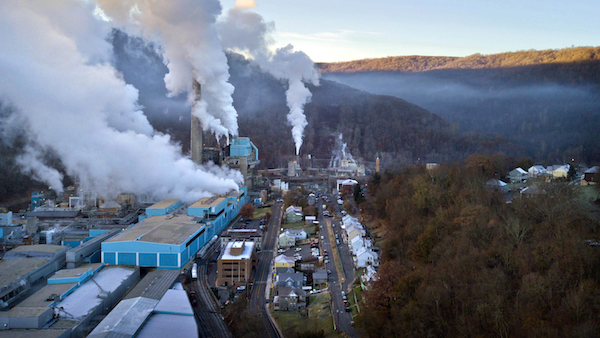SEJournal Online is the digital news magazine of the Society of Environmental Journalists. Learn more about SEJournal Online, including submission, subscription and advertising information.
 |
| Scott Dance's award-winning series focused in part on the 228-acre Verso paper mill, seen above left, dwarfing the town of Luke on the banks of the Potomac River in Western Maryland. The Sun reported on how the plant generates much of its own power by burning "black liquor," a sludge byproduct of the paper-making process. Photo: With permission from Jerry Jackson/Baltimore Sun. Click to enlarge. |
Inside Story: For ‘Wonky’ Pollution Story, Making the Complex Clear
Alternative energy facilities in Maryland are subsidized under a years-old state program. But many of them, including a paper mill and a trash incinerator, are pouring greenhouse gases and harmful toxins into the environment. In a series of reports supported with a grant from the Society of Environmental Journalists, The Baltimore Sun’s Scott Dance investigated the problem in a package that won the outstanding explanatory reporting second-place award in the SEJ's 2018 Annual Awards for Reporting on the Environment.
SEJ's judges called the multimedia project well reported and engaging and said “it brought nuance in understanding the history and meaning of the paper mill to the local town, its changing role and the challenges for adoption of newer forms of renewable energy.” They added that the series “did a great job of localizing a broad and complex topic while staying accessible to everyone [and] beautifully illustrated how macro changes affect everyday lives.”
SEJournal Online's "Inside Story" caught up via email with project reporter Scott Dance. Here is the conversation.
 |
How did you get your winning story idea?
It came out of years of beat reporting on energy and environmental issues. It was the sort of story that it was easy to assume was already widely known, but actually wasn't. It just needed both a deeper dive and a dumbing-down for the average reader.
What was the biggest challenge in reporting the series and how did you solve that challenge?
The hardest part was figuring out how to make it interesting and digestible to the average reader. At the center was a state renewable energy incentive program that was both obscure and extraordinarily complicated. My solution was to focus on the people affected by it, and use their stories as a container for the wonky policy issues at the heart of the matter.
What most surprised you about your reporting/findings?
Honestly, I was most surprised that people ended up being interested in what I wrote. I was never quite sure if I was doing enough to engage the most casual of readers, but got many positive responses from them, as well as the interest of the policymakers who have power over the renewable energy program.
How did you decide to tell the story and why?
I had written shorter stories touching on an apparent hypocrisy within Maryland renewable energy incentives in the past, and always wondered why it didn't get more attention. I just hit a point where I decided it needed more attention, and was able to get the support and buy-in of colleagues in my newsroom to make it happen.
What would you do differently now, if anything, in reporting or telling the series and why?
I would have spent more time in the Western Maryland towns where two of the stories in the series were centered. I feel like I only scratched the surface of the ways this state program and renewable energy development touch on the sense of feeling left behind that is so pervasive in rural parts of the country. It could have placed this series within an even larger narrative.
Providing characters and a narrative
that readers can care about and follow
can lead readers through material
they would otherwise expect to have no interest in.
What lessons have you learned from your project?
I learned a lot about how to make complicated, seemingly boring or wonky topics engaging to the average person. Providing characters and a narrative that readers can care about and follow can lead readers through material they would otherwise expect to have no interest in.
What practical advice would you give to other reporters pursuing similar projects, including any specific techniques or tools you used and could tell us more about?
I would just say, always be thinking of your mom or your neighbor or your barber when crafting a story about a complex topic that doesn't seem immediately accessible.
Scott Dance writes about the environment and the weather. Since joining The Sun in 2012, he has covered snowstorms and hurricanes, crabs and oysters. His award-winning 2017 series "Power Struggle" detailed how a green energy subsidy program benefits polluting industries. He has two degrees from the University of Maryland and is a Timonium native.
* From the weekly news magazine SEJournal Online, Vol. 4, No. 29. Content from each new issue of SEJournal Online is available to the public via the SEJournal Online main page. Subscribe to the e-newsletter here. And see past issues of the SEJournal archived here.














 Advertisement
Advertisement 



